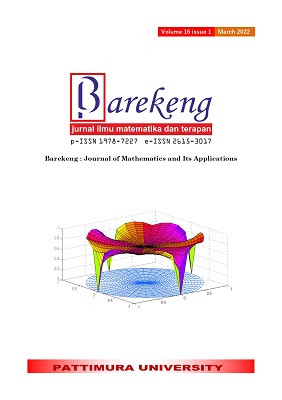THE SOLUTION OF MATHEMATICAL MODEL OF OTOBUS TICKET SALES WITH REFERRAL MARKETING STRATEGY
Abstract
One of the ways to involve customers in marketing strategies is known as the referral strategy. This strategy has been applied in various fields for marketing, one of which is in the field of transportation. This study aims to determine the solution to the mathematical model of bus ticket sales using a referral strategy. The data in this study is bus passenger data throughout 2020 which was obtained from one of the Otobus companies in Jakarta. Mathematical model that is compiled using the analogy of the model of the spread of disease. The results of this study are a mathematical model of bus ticket sales using a referral strategy consisting of 4 compartments. The model solution is determined by iterating over the system of differential equations that has been formed. Based on the solution obtained, the simulation results show that the referral strategy in bus ticket sales is able to increase bus passengers up to 39.92%.
Downloads
References
L. Zakizadeh and N. Atghia, “The Presence of New Technologies Affected on Ticket Sales Management in the World Sport Mega Events Methodology of the research,” vol. 3, no. 2, pp. 50–60, 2020.
L. Rusmawan, Word of Mouth Communication : Penjualan Produk. Surabaya: Media Sahabat Cendikia, 2019.
S. Kundu and C. S. Rajan, “Word of Mouth : A Literature Review,” Int. J. Econ. Manag. Scieces, 2017, doi: 10.4172/2162-6359.1000467.
S. Frank, “Marketing Budgets are Growing Again, Say CMOs, and Marketing’s Standing as Well,” Credit Marketing Officer, 2021. Cmo.org/.
F. Naz, “Word of Mouth and Softdrink,” Int. J. Sci. Res. Publ., vol. 4, no. 1, pp. 1–4, 2014, [Online]. Available: www.ijsrp.org.
P. Schmitt, B. Skiera, and C. Van Den Bulte, “Referral programs and customer value,” J. Mark., vol. 75, no. 1, pp. 46–59, 2011, doi: 10.1509/jmkg.75.1.46.
M. A. Rudhito and D. P. W. Putra, “ Solution of the SIR Mathematical Model for the Spread of Covid-19 Using GeoGebra ,” Proc. 7th Int. Conf. Res. Implementation, Educ. Math. Sci. (ICRIEMS 2020), vol. 528, no. Icriems 2020, pp. 303–308, 2021, doi: 10.2991/assehr.k.210305.043.
E. L. Piccolomini and F. Zama, “Monitoring Italian COVID-19 spread by a forced SEIRD model,” PLoS One, vol. 15, no. 8 August, pp. 1–15, 2020, doi: 10.1371/journal.pone.0237417.
F. Brauer, C. Castillo-Chavez, and Z. Feng, Correction to: Mathematical Models in Epidemiology. 2019.
D. P. W. Putra and M. A. Rudhito, “Mathematical model of referral marketing strategy,” J. Phys. Conf. Ser., vol. 2106, no. 1, 2021, doi: 10.1088/1742-6596/2106/1/012010.
S. Ghosh, S. Bhattacharya, K. Gaurav, and Y. N. Singh, “Going Viral: The Epidemiological Strategy of Referral Marketing,” 2018, [Online]. Available: http://arxiv.org/abs/1808.03780.
S. Ghosh, K. Gaurav, S. Bhattacharya, and Y. N. Singh, “Ensuring the spread of referral marketing campaigns: a quantitative treatment,” Sci. Rep., vol. 10, no. 1, pp. 1–15, 2020, doi: 10.1038/s41598-020-67895-6.
D. Lacitignola, “Handling hysteresis in a referral marketing campaign with self-information. Hints from epidemics,” Mathematics, vol. 9, no. 6, 2021, doi: 10.3390/math9060680.
H. S. Rodrigues and M. J. Fonseca, “Viral marketing as epidemiological model,” no. Vm, 2015, [Online]. Available: http://arxiv.org/abs/1507.06986.
Hall Jonas and Thomas Lingefjard, Mathematical Modelling Applications with GeoGebra. New Jersey: Wiley, 2017.
Authors who publish with this Journal agree to the following terms:
- Author retain copyright and grant the journal right of first publication with the work simultaneously licensed under a creative commons attribution license that allow others to share the work within an acknowledgement of the work’s authorship and initial publication of this journal.
- Authors are able to enter into separate, additional contractual arrangement for the non-exclusive distribution of the journal’s published version of the work (e.g. acknowledgement of its initial publication in this journal).
- Authors are permitted and encouraged to post their work online (e.g. in institutional repositories or on their websites) prior to and during the submission process, as it can lead to productive exchanges, as well as earlier and greater citation of published works.






1.gif)



